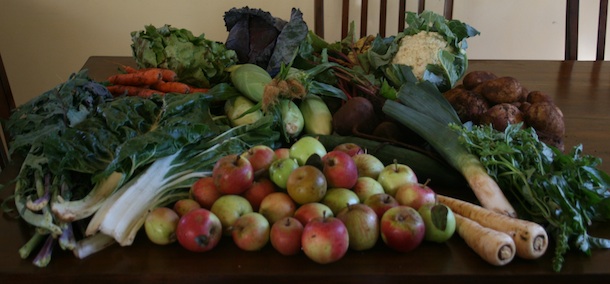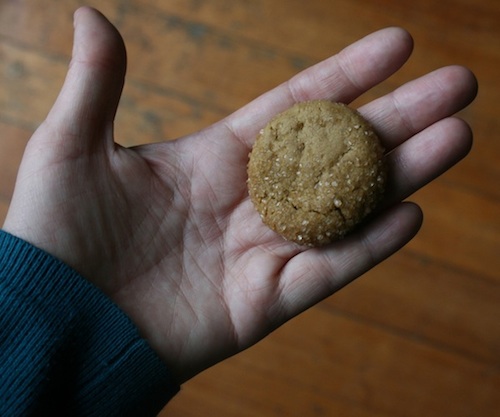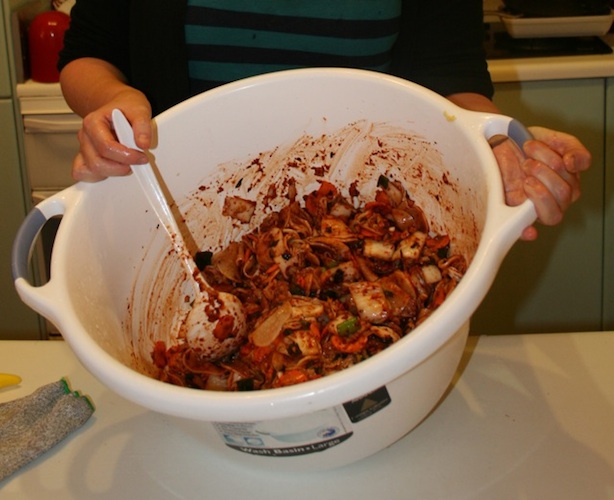I’m 38, and I don’t know how to drive a car. I started riding a bike to get myself places when I was about 32, and since then that has generally been both lovely and sufficient for getting places public transport doesn’t go. Almost the only time I wish I could drive is on weekends, when I contemplate the task of getting to a farmers market and schlepping home a week’s worth of vegetables, fruit, meat and cheese via some combination of train, tram and laden walking. I’ve been getting lazier about doing that, which has led to a few weeks of fairly uninspired eating of Coles vegetables, and other weeks of living mostly on tomatoes and greens from the garden (delicious, but not really enough to survive on).
But recently I’ve been trying out an option that involves much shorter schlepping distances, while also supporting a local organic farmer: Whole Larder Love seasonal veg boxes, organised by Rohan Anderson and Kate Berry. If I decide I want a box this week, I order one on the online shop by midnight Wednesday, and then on Saturday morning I head over to St Kilda to pick it up from Rohan or Kate between 9 and 9.30. They also have three other Saturday drop-off points, at Merri Creek, Footscray and Ballarat. For $48 I get a huge box of excellent and ultra-fresh vegetables and fruit grown by an organic farmer between Ballarat and Daylesford and picked the previous day. And I really do mean huge – it’s a reused styrofoam produce box packed to the brim with food. I can get it home on the tram, but get some impressed/bemused looks while doing so.
When I picked up the veg box this Saturday, I had a little chat with Kate, and she mentioned that some people weren’t sure that they could eat the whole box between a household of two people. The obvious answer is to share the box with a friend or neighbour! But I also reckon it isn’t that hard to eat it between two people if you’re making lunches and dinners for a week, and I thought I’d write up what we did with our last one to demonstrate. Admittedly, we’ve had Janine staying with us while she looked for a new place to live. But last week she was only there for half the meals we ate, and she did a bit of vegetable shopping on the side, so I reckon it works out about even.
Here’s a photo of the contents of last week’s box:

There were potatoes, carrots, silverbeet, kale, a bunch of beetroot, parsnips, turnips, a cauliflower, a red cabbage, a lettuce, five cobs of corn, a leek, a cucumber, a couple of tomatoes, basil, lots of apples, and two nashi. We made it through (almost) all of this in eight days, while also eating piles of tomatoes, greens, herbs and figs from our garden, and going out to eat a couple of times. If we’d eaten at home every meal we would easily have finished it all off in seven days.
********
Here’s our week in food. Items from the veg box are bolded; most other ingredients came from the garden.
Saturday 9th: Ted drove us over to St Kilda to pick up the veggie box at 9. On the way home, we picked up a loaf of sourdough and a cheese danish at Baker in the Rye and had coffee at Las Chicas. I unpacked the box, laid all the veggies out on the table and photographed them, and wondered whether we could eat it all in a week. We started small for lunch: a salad of lettuce, cucumber, fresh corn, tomatoes, mint, basil, parsley and rocket, with sourdough and the Bruny Island cheese I brought back from Tasmania last week. A nashi and a small apple finished off the meal.
It was about 36 C, so we fled to the cinema to watch Cloud Atlas and enjoy the air conditioning in the afternoon, and came home and ate Frosty Fruits for dinner. Percent of the veggie box eaten so far: probably about 2%. Not looking good.
Sunday 10th: I got up early, while it was still a reasonable temperature, and roasted the two large beetroot in the oven, to eat later in the week. I’ll keep the two smaller beetroots for eating raw in salads. An hour of gardening, and then it was too swelteringly hot to object too strongly to Ted’s plan for lunch at a cafe. (He ate eggs benedict, a.k.a. eggs with egg sauce; unthinkable in the middle of summer! I had vietnamese-style squid salad.)
However, we pulled ourselves into shape for dinner and made two indian dishes: gobi mutter masala (using up cauliflower and tomato) and hariyali dal (silverbeet). I was planning to also add a chicken and potato curry, but after making these two my whole body was already running with perspiration and I was ready for my third cool shower of the day. Screw you, heatwave.
Monday 11th: Janine and I took some of the left-over curries to work for lunch, and then she made a third curry to add to them for dinner – fish and potato, excellent.
Tuesday 12th: All three of us did our curry-eating duty and had the last of the left-overs for lunch. Nichola and Rene came over for dinner, to celebrate Janine getting the apartment in Caulfield she’d applied for (hooray!), so we made a vegetably feast:
– An incredibly delicious beetroot and greens frittata. This was one of the best things I ate all week. I peeled and chopped the two large beetroot I’d roasted on Sunday. Chopped the white part of a leek and sauteed until soft. Blanched some chopped greens: a dozen beet leaves and about 8 large chard leaves. I wilted a small bunch of chopped sorrel leaves with the leek, then mixed together the leek, the drained greens, the beetroot, a large bunch of chopped mint, 90 g of feta, and four eggs. This got cooked slowly in a small frypan over low heat until almost set, then finished under the grill. It made a fat, vegetable-dense frittata about 4 or 5 cm deep and a bit over 15 cm across.
– The remaining cobs of corn, which we soaked in water for 30 minutes, then barbequed in their husks, and ate with butter, lime juice and smoked paprika.
– Potatoes, washed, boiled until almost cooked, roughly smashed in a baking dish, drizzled with olive oil, salt and pepper and roasted until crisped around the edges.
– Blanched green beans tossed with pesto (made with basil from the veg box).
– Ripe tomatoes from the garden, sliced and dressed with balsamic vinegar, olive oil, parsley and chives.
Despite all this we still had room for the apple cake Nichola had brought for dessert.
Wednesday 13th: We took frittata, bean and potato left-overs for lunch. For dinner, after pilates, I made a quick dish of pasta with the remaining pesto, and eggplant.
Thursday 14th: We had lunches of salad made with lettuce, cucumber, grated raw beetroot, tomatoes, rocket, young chard leaves, sorrel, parsley, mint, feta and chopped hazelnuts.
The heatwave finally broke this morning, and although the temperature is still in the mid twenties, it feels blissfully cool. I made chicken and vegetable stew for dinner: five browned drumsticks; onion and fennelseed; two potatoes, two parsnips, six carrots, all peeled and chopped; half a bottle of white wine, two cups of water (chicken stock would have been better), fresh bay leaf, sprig of rosemary, salt, pepper. Covered, in the oven at 160 C for an hour, then added a bunch of blue kale, chopped, and cooked a further 30 minutes, partly uncovered. We ate this with toasted italian bread and a scatter of lemon zest.
Friday 15th: left-over chicken stew for lunches. For dinner, it was a fight between the urge to cook more vegetables, and the almost unbroken tradition of going out for dumplings with the lab. Tradition won.
Saturday 16th: I trammed over to pick up this week’s veg box, and met Helen there. We checked out the Little Veggie Patch shop on Chapel St, had coffee and breakfast (leek and corn fritters with herbed yoghurt) at Garage Espresso, and then she dropped me home and accepted a few items from the box as fair exchange.
Even though there is a new box of vegetables in the house, I wanted to clean up as much of last week’s box as possible today, and made a pretty good effort. I stewed the remaining apples to make compote for breakfasts next week. Ted and I split a salad for lunch that I adored and he ate graciously because he loves me and has good manners. It was fantastic: a small beetroot, coarsley grated; 6 tender small beet leaves, stemmed and finely sliced; a cheek of a red cabbage, finely sliced; one scallion, and quite a bit of mint, parsley and chives, all finely chopped; 100 g hot-smoked salmon fillet, flaked. Toss all this together, with a dressing of olive oil, white wine vinegar, seed mustard and a pinch of salt. Visually delightful, and a perfect combination of flavours.
And then for dinner we made gnocchi from scratch. I’ve never made them before; I’d been scared off by too many stories of them being a hassle to make, and the risk of putting in the effort and ending up with bullet-like dumplings rather than light little clouds. I consulted Artusi and Marcella Hazan and gave it a go, figuring that I could always just cook some dried pasta if they turned out badly. But no! They were great, and very very simple and quick to make. I boiled three potatoes (a bit over 400 g) in their skins until just cooked, then drained them. While they were still hot, I peeled them and put them through a potato ricer, then mixed in about 80 g of plain flour. The recipes called for a little more flour than that – about 25% as much flour as potatoes by weight, typically – but the dough was coming together nicely and not too sticky, so I stopped. We formed them into gnocchi, following the illustration in Hazan’s Essentials of Classic Italian Cooking, cooked them in gently boiling water for a minute or so until they bobbed to the surface, and were kind of flabbergasted when we tried one and it turned out to be perfectly light and fluffy. We ate them with a slow-cooked tomato sauce and a grating of parmesan.
********
What’s left over? Two turnips and three-quarters of a red cabbage. I’m not sure what I’m going to do with the turnips, but I’m thinking of roasting the cabbage with za’atar as part of a mezze plate, or turning it into more salads, like this or this.
The week’s best dishes? Surprisingly to me, they were both made with beetroot, a vegetable I’m perfectly happy to eat but don’t usually go crazy for: Tuesday’s beetroot and greens frittata, and Saturday’s beetroot, red cabbage and smoked salmon salad. I was also really stoked about making great gnocchi.
Will I still go to farmers markets? Yes – sometimes I want to get to chose the vegetables I’ll eat for the week, and if I need to buy meat or cheese I’ll often go to the farmers market for that, and will just pick up vegetables while I’m there. But I’ll also keep getting the veg boxes, even if not every single week, because I like the idea, I’m impressed with the produce, I like the people involved, it’s super convenient, and it presents me with vegetables I wouldn’t often think to buy (beetroot, potatoes, cabbage) and encourages me to explore new recipes.
Now to settle down to working through this week’s veg box. Anyone got suggestions for green cabbage, and those turnips?






